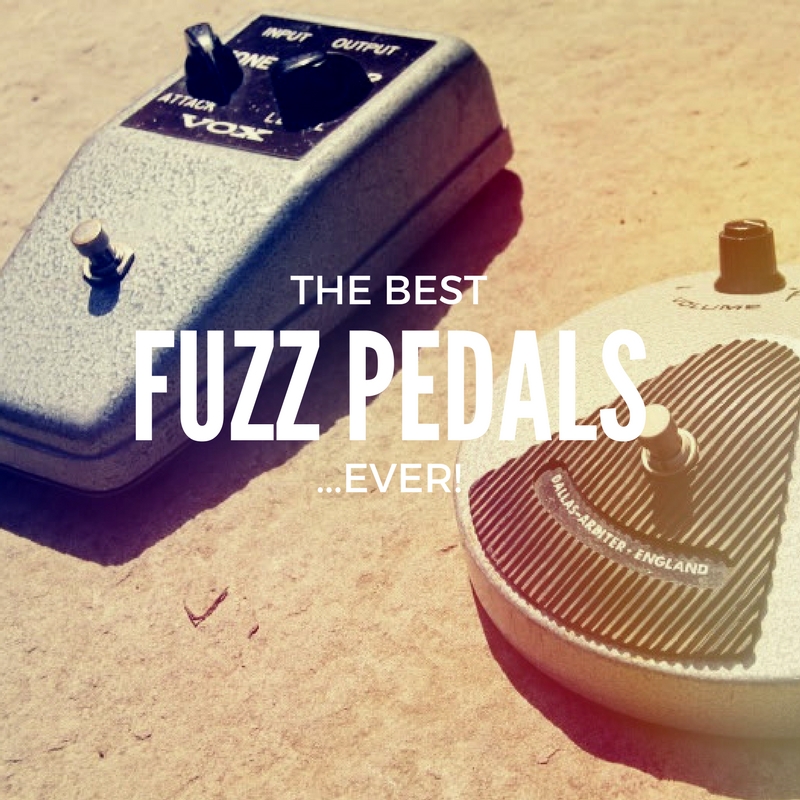
We just LOVE fuzz pedals, don’t we? They are pretty much the most “classic” of all guitar fx pedals: one of the earliest types of effect, used on several seminal recordings from the Sixties, and still popular today. But one question remains: WHAT are the best fuzz pedals, ever?
The history of fuzz is suitably… fuzzy! There are many different reports as to which was the earliest song to feature the sound characteristic of fuzz, or something akin to it, and its origins are closely related to the development of the distortion sound for guitars – and the very birth of rock’n’roll itself.
A Time Before Fuzz: the Origins of Distorted Guitar Sounds
Before we get into fuzz itself, let’s go back to the origins of the distorted guitar sound. All the first guitar amps were analogue, tube amps. When guitarists started to experiment with their amps – or have accidents! – that’s when distortion was born.
Goree Carter‘s “Rock Awhile” (1949) has an overdriven guitar sound, and the song is pretty much the birth of rock’n’roll – you can almost hear where Chuck Berry got his ideas from.
Famously, “Rocket 88” (1951) by Ike Turner/Jackie Brenston (often referred to as the “first” rock’n’roll song) is said to feature a guitar amp with damaged speaker cone, though the guitar is quite low in the mix.
For 1956’s “The train kept a rollin'” by the Johnny Burnette Trio, a guitar amp with dislodged tube was used to create a dirty guitar sound, and a few years later it was the turn of Dave Davies to slash his amp’s speakers for the dirty sound of The Kinks‘ “You Really Got Me”.
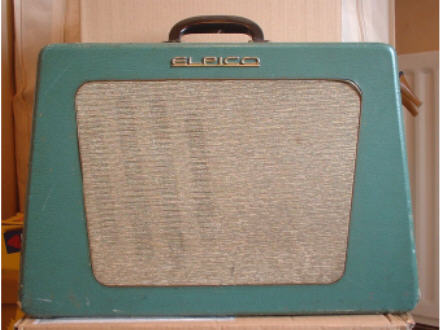
Kinks’ fuzz: Elpico AC-55 with slashed speakers plugged into Vox AC-30. Damn… glad it’s easier to just use a fuzz pedal nowadays!
The Fuzz and Muff Pedal Timeline has a pretty good list of other pre-fuzzbox songs.
None of those tracks use “fuzz” exactly, but they all presaged the desire for dirtier guitar sounds – which the first fuzz pedals made much easier!
Who Invented the First Fuzz Pedal?
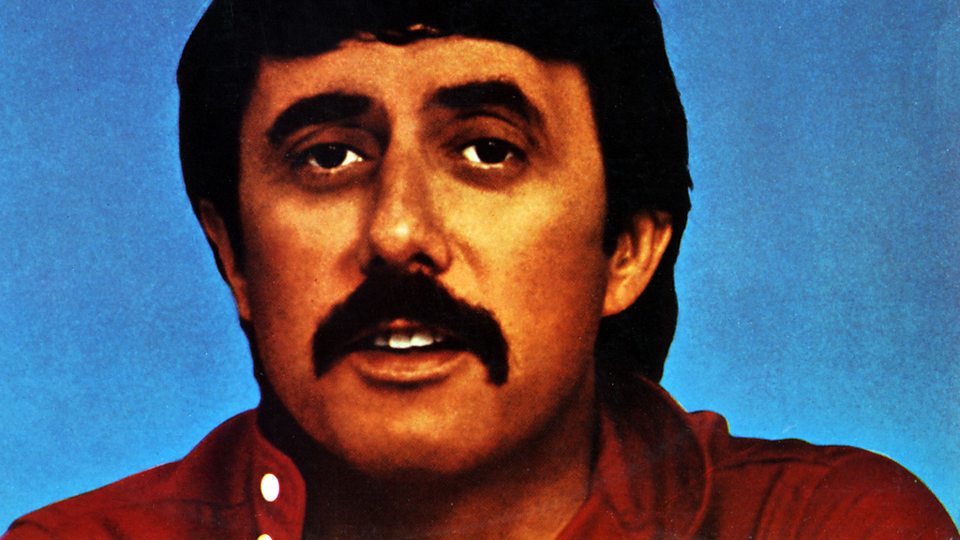
Thank you for the fuzz… and no, we’re not talking about the ‘tache! (great as it is)
Lee Hazelwood was one of the most important fuzz pioneers: he asked a (sadly anonymous) radio station technician to make a custom fuzz box to be used in the studio – and it features on Sanford Clark’s 1960 song ‘Go On Home’ which is believed to be the first-ever track to feature an electronic device created specifically to create a “fuzz” sound… ie, the original fuzz pedal! (sadly, there are no pics of this legendary device…)
After this, more artists began to have an interest in that new, specific sound – the FUZZ! Orville Rhodes created the legendary Rhodes Fuzz boxes, used by Billy Strange and The Ventures, and after that, the history of fuzz really took off.
With the creation of the first commercially available fuzz – the Maestro Fuzz Tone – it was just a matter of time until a new generation of musicians fell in love for the dirty sounds of fuzz and it became a crucial sound in rock’n’roll ever since!
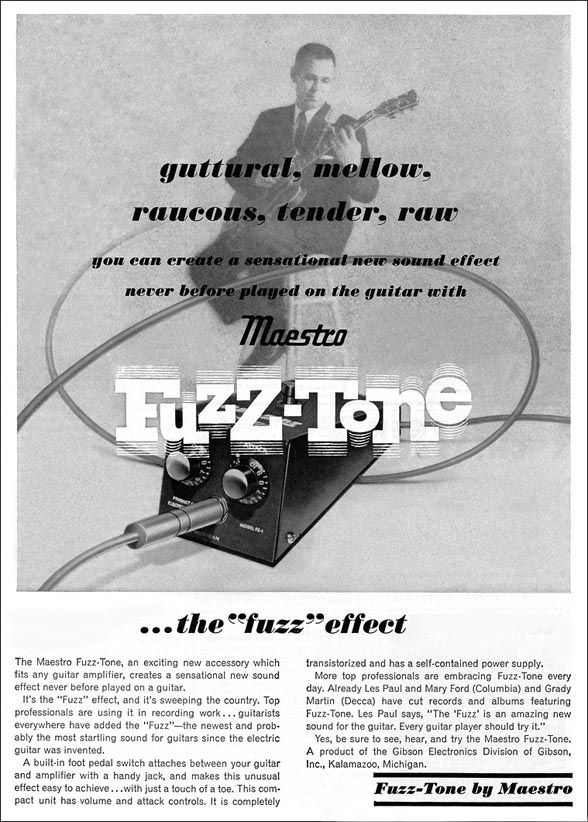
vintage Maestro Fuzz Tone ad
Fuzz vs. Distortion vs. Overdrive: What’s the difference?
Sometimes they get mixed up, because they do a similar job – to make your guitar “dirtier’! But they are all different.
It’s all to do with how they change the dry signal of the guitar – there are many sites that’ll explain this in detail, with images of the sound wave shapes they generate etc but, well, it can be a bit boring, really! What really matters is how different do they actually sound?
All you need to know is that overdrive sounds more “natural” (more like an overdriven amp sound) and smooth, and is the least harsh-sounding of the three. Distortion does what it says in the box, and sounds more kick ass than an overdrive, but not as harsh as fuzz. Think Nirvana, for instance.
You can use an overdrive pedal on an already overdriven tube amp, and thus get a sound that could be described as distorted, as if you were using a distortion pedal on a clean amp.
And then, there’s what interests us here: FUZZ!!! It’s a very different and altogether wilder beast…
This great video explains the differences:
Overdrive and Distortion pedals were developed years after the first fuzz pedals. In fact, it’s no coincidence that they were developed after the invention of solid-state amps, because that’s what they were actually made for – since SS amps can’t naturally be overdriven like valve amps.
It’s interesting to notice that most fuzz pedals sound much better when used with valve amps than with solid state amps, whereas overdrive and distortion can sound good with either. Maybe that’s a good subject for another blog… but maybe, it has to do with the fact that fuzz was originally designed to interact with valve amps, especifically!
Fuzz is one of the oldest types of guitar effects (as explained before) so it’s a very simple effect, and not very subtle, generally. This means two things:
1) most circuits can be easily copied, so that’s why you’ll find lots of Tone Bender, Fuzz Face, Big Muff etc copies (often more affordable, sometimes way more expensive than the originals!)
2) If you don’t know what you’re doing, your fuzz can sound bad!
Fuzz pedals (using germanium or silicon transistors) can sound very harsh, it’s true, but the best ones interact beautifully with your guitar, and knowing how to use your guitar’s volume and tone can greatly affect the results. Some fuzzes will sound terrible when you play chords, but are great for solos.
One of the joys of using fuzz is that despite it being a simple guitar effect, you really need to “play” the pedal – it’s often not just about stepping on it and turning it on, but about learning how it works with your guitar, amp and other pedals, fine tuning the settings. In many cases, if you’re a guitarist who only uses your guitar volume at 10, you simply won’t make the most of your fuzz pedal – fuzz pedals can be the wildest and most “in your face” of guitar effects, but really, they’re all about the subtleties of the player.
If you don’t know how to use your fuzz pedal, it can sound bad… but if you do it right, it could be the best sound ever!
What Are The Best Fuzz Pedals… Ever?
Well, to pick any Top 10 “Best Of” is always difficult, and controversial… and it won’t be any different this time! But to make things easier, we set a few basic rules:
- No rare “boutique” pedals (instead, we chose those which were/are more-or-less easily available in the shops at one point or another)
- We chose pedals which have been used by well known artists
- Also, we’ve chosen mostly original pedals which inspired copies rather than clones.
There are SO many boutique clones out there that the list to choose from would be endless and generate even more discussion – there’ll be many people who’ll say that “such and such Big Muff/Fuzz Face clone is miles better than the original”, so we simply won’t get into this kind of argument – boutique clones are out! We’ll stick with the classic originals. Some pedals here HAVE been inspired by other models, but over the years made a name and inspired clones themselves, so we’ll include them.
It’s interesting to note that, because fuzz is generally a very simple and primitive effect, lots of good, cheap clones also DO exist – but here you’ll find the pedals that got more than just a great sound – they got MOJO to spare…
Death By Audio Fuzz War
Why? It’s quickly becoming a classic alt-rock / psych favourite, thanks to being used by bands such as Thee Oh Sees. It CAN give you some great fuzz tones, and is also great for some mad noises… a new classic? You bet! Also, American brand Death By Audio is one of the best right now…
Univox Super fuzz
Why? This octave-up fuzz, made by the Japanese Univox company, is without a doubt one of the most legendary ever made. Users include Pete Townshend (The Who), Poison Ivy (The Cramps), Billy Corgan (Smashing Pumpkins), J. Mascis (Dinosaur Jr.) and many others. It was also featured in the title of Mudhoney’s debut album, “Superfuzz and Big Muff”.
WEM Pep Rush Box
Why? Because it’s one of the few well-documented fuzz boxes used by The Beatles. John Lennon used it on ‘Paperback Writer’. A modern reissue looks and sounds the part, too. This is NOT a “Beatles-in-a-box” though, since the Fab Four used it sparingly. However, this connection with the Liverpool band was enough to make this pedal the stuff of legend and more desirable – but it is a great fuzz too, perfect for dirty Cramps-style rock’n’roll, meaty riffs and ripping solos… a great addition to any guitarist’s arsenal!
Foxx Tone Machine
Why? This is a legendary octave-up fuzz, introduced in 1971 and now quite rare (though reissued not that long ago). Users included Peter Frampton, Adrian Belew, Parliament / Funkadelic and Nine Inch Nails. One of the cool features – innovative then – is that it has a toggle switch to select octave up fx or turn it off… making it more versatile than the Roger Meyer Octavia. The Foxx Tone Machine inspired clones such as the super cheap Danelectro French Toast fuzz and the Joyo Octave Fuzz.
Roger Mayer Octavia
Why? This is the original octave-up pedal, as pioneered by Jimi Hendrix on songs such as ‘Purple Haze’. As if you needed any more reasons! Octave up fuzz pedals can be tricky affairs to use – but if you do it right, a very cool addition to a guitarist arsenal!
Shin-Ei FZ2
Why? The Japanese Shin-Ei is one of the most sought-after fuzz boxes out there, quite a collectors item, and has been used by bands such as Jesus And Mary Chain (on classic debut ‘Psychocandy’), Blur, Radiohead (in ‘OK Computer’!) and the Black Keys.
Maestro FZ-1 Fuzz Tone
Why? Mojo to spare!!! This is THE fuzz pedal that made fuzz popular, thanks to one song: ‘Satisfaction’ by the Rolling Stones. According to Keith Richards, he only used the relatively new pedal with the intention of using it for the demo, to mimic the sound that should be played by horns in the final version. However, the fuzz became the most essential part of the released version, and the rest is history… the fuzz craze was born!
Interesting to note that on the first ever demo of a fuzz pedal, they were basically trying to compare the Maestro Fuzz-Tone sound with traditional instruments such as cello or saxophone, as its main “selling point”!
Z-Vex Fuzz Factory
Why? This is one of the craziest fuzzes out there, capable of self-oscillating… ideal for the noise experimentalists. You’ll find more than just a few people who think this is their favourite fuzz ever, and some of its most famous users include J. Mascis (Dinosaur Jr.), Stephen Malkmus (Pavement / The Jicks), Annie Clark (St. Vincent) and Matt Bellamy (Muse). The Fuzz Factory became such a crucial part of Bellamy’s sound, tat he had guitars custom-made for him, with built-in Fuzz Factory!
Not many fuzz pedals are as versatile as the Fuzz Factory. You can do mad things with it, but it’s also a great-sounding fuzz, like few others!
Tone Bender
Why? The Vox Tone Bender (in its many different incarnations) is one of the most widely used and iconic fuzz pedals ever. List of famous users include Jeff Beck (The Yardbirds) , Jimmy Page (The Yardbirds, Led Zeppelin), The Beatles (bass on “Think For Yourself”), Mick Ronson (Ziggy Stardust-era Bowie), Marc Bolan (T-Rex) and Pete Townshend (The Who). Inspired countless clones and modern reissues that sound as good as vintage ones. Whichever you choose… it’s likely to be amazing!
Fuzz Face
Why? Once again, Jimi! More than anyone else, it was Jimi Hendrix the one guitarist most responsible for popularising fuzz… and his weapon of choice was a Dallas-Arbiter Fuzz Face. It’s virtually impossible to think of Jimi without thinking of the Fuzz Face, which he knew how to use like few others. Jimi was the textbook case of how to use fuzz and be able to be subtle or wild, depending on how you use it. Many other players used it… rom David Gilmour in Pink Floyd to, more recently, the Black Angels.
The Fuzz Face has had many incarnations and inspired countless clones…. and today Dunlop makes quite a few versions (including “mini” sized ones) which all sound unmistakably “Fuzz Face-y”, with minor – but to some crucial – differences in terms of tone. Whichever you choose – it’ll give you one of the most classic and most delicious fuzz sounds, ever!
Electro-Harmonix Big Muff
The big one, and not just the name! Arguably the most popular fuzz ever. The king of all fuzzes… the Electro-Harmonix Big Muff! This pedal has been used in records by most artists you care to think of… from Pink Floyd and David Bowie to Nirvana, Red Hot Chilli Peppers… and even The Carpenters!
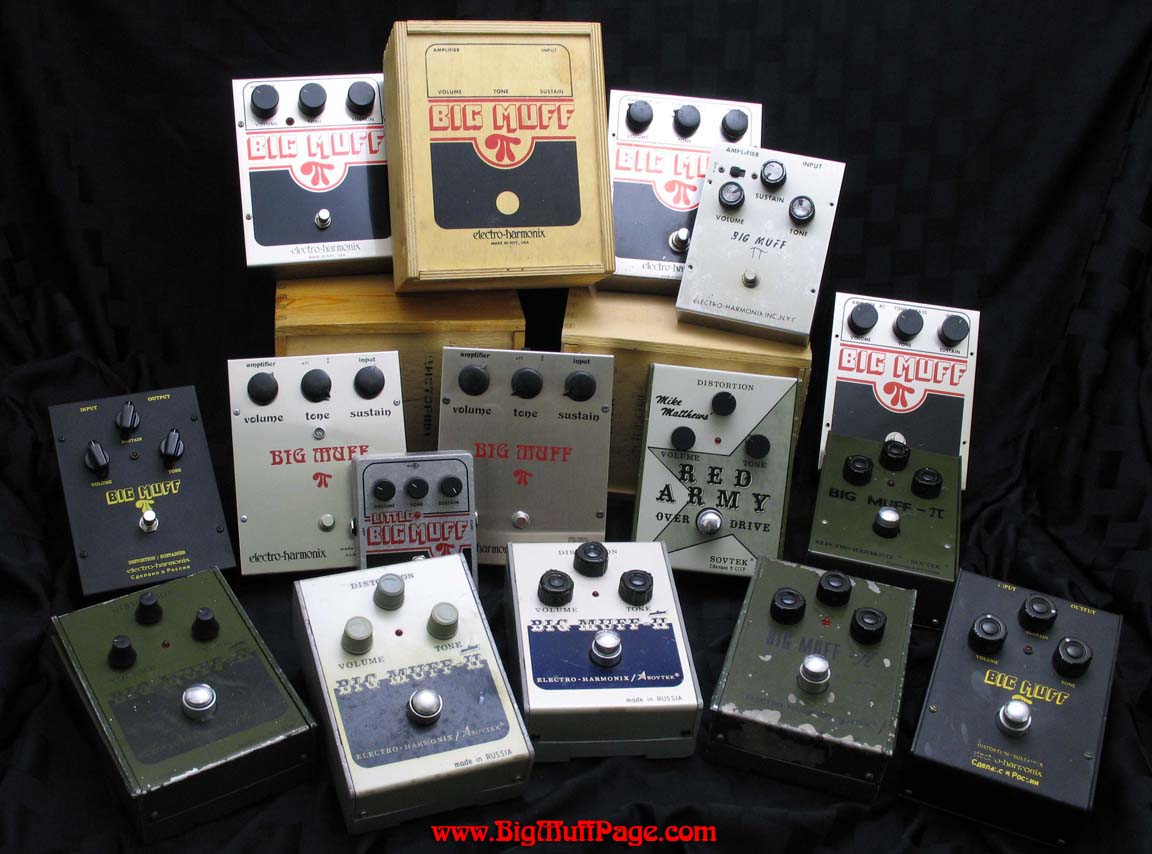
A lot of Muffs…
The beauty of it is that it’s still widely available and relatively cheap. Bands big or small still use it, in dive bars and stadiums alike, worldwide, every day. There are many different versions – including the reissue of the famous “green Russian” – which, despite a few small differences pretty much sound like you’d expect a Big Muff to sound – so you can pick any safe in the knowledge it’ll be amazing! (ps: beware the EHX Germanium Big Muff Pi though. It’s a pretty cool pedal but the only one from their “Muff” range that doesn’t really sound “Big Muff-y”. As a versatile distortion pedal, it’s great. As a Big Muff fuzz… you’d be probably disappointed)
Even though the Electro Harmonix Big Muff never really lost popularity, there’s little doubt that, in the 21st Century, Dan Auerbach and Jack White helped to make this pedal even better known, and today it’s still one of the best-selling pedals around!
In our experience, we still see a LOT of people who own an Airline guitar and, lo and behold, 9 out of 10 times they also have a Big Muff!
No wonder – this combo sounds immense!
Now… YOUR turn to tell us: what’s your favourite fuzz pedal?

Stunning lack of mention of the Mosrite Fuzzrite.
I have a number of fuzz pedals for tunes from the mainstream music catalog. When it comes time for creative or otherwise dynamic expression however, it’s the Fuzz Face and the Proctavia hands down.
Thanks for the guide. I did like to make an inclusion of Donner Guitar Stylish Fuzz. I have been using this pedal for some time and I think this is the best pedal I have used in a while.